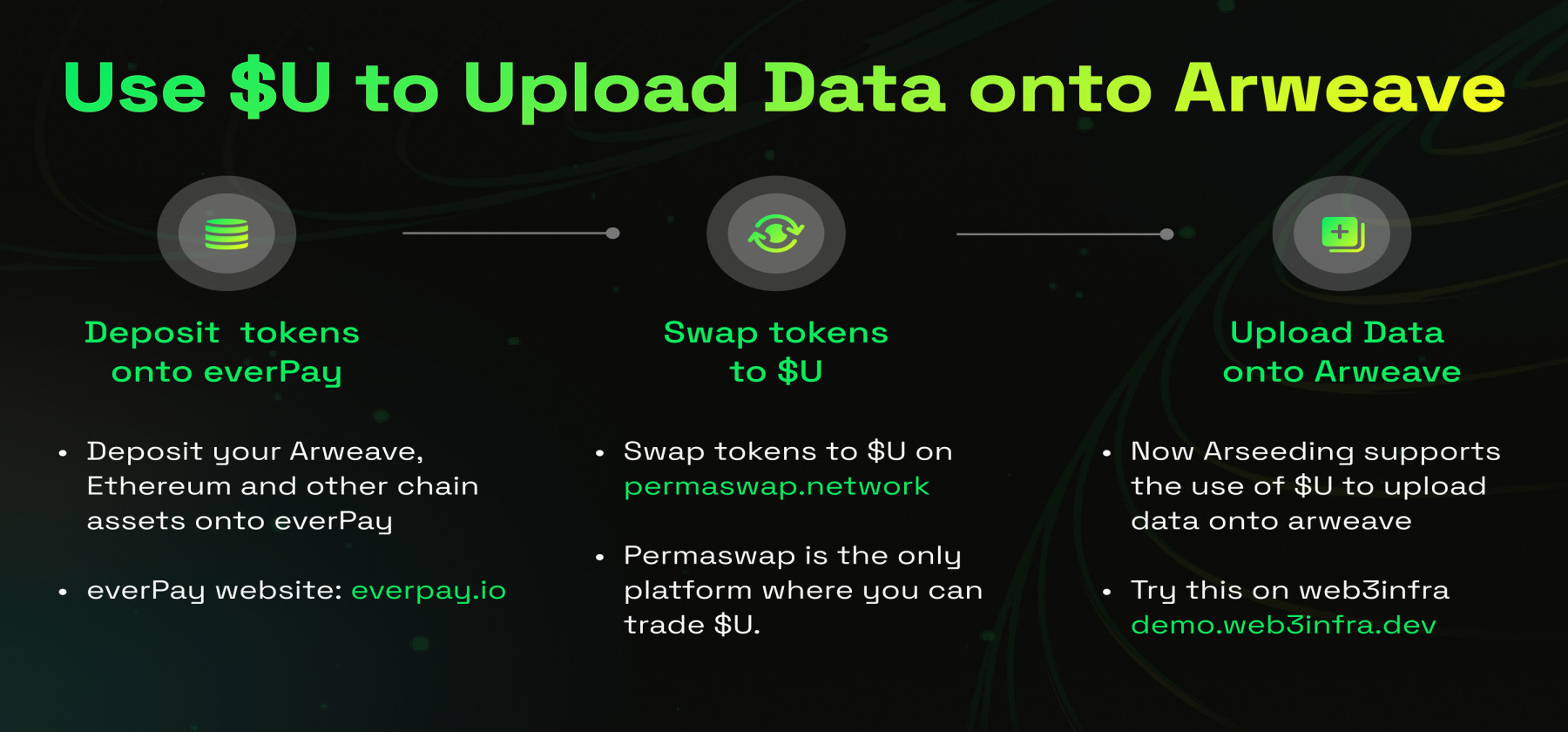
Use $U to Upload Data onto Arweave
As $U has been listed on Permaswap, a new chapter in Permaweb's development begins. People are now using Permaweb to store, burning AR to pay storage fees, while simultaneously receiving $U as storage proofs.
$U is a token issued on Smartweave, which is the abbreviation for Unit. The relationship between AR and $U is similar to that between ETH and WETH. While AR pays for storage fees within the ecosystem, it lacks the ability to be invoked in smart contracts. $U, on the other hand, is highly versatile and programmable, serving as a catalyst within the Arweave ecosystem.
$U is minted in a fully decentralised manner, meaning that no one can mint $U out of thin air. The only way to obtain $U is by using AR to pay for storage fees. This relationship means that the supply of $U is deeply connected to Arweave usage.
As a public asset on Arweave, $U will have various use cases within the Permaweb ecosystem.
Due to the widely dispersed nature of $U holders, there is less of a risk of market manipulation by whales. This increases the network's resilience and decentralisation, encouraging more users to store data on Arweave.
https://cdn.staticaly.com/gh/meininghang/image-hosting@main/image.1lfnu9pvgwhs.jpg
Using $U for Permanent Storage
Many members of the ecosystem have recently been asking if $U can be used for permanent data storage, similar to AR. The answer is yes!
How to Get $U
Tutorial: https://permaweb.news/trade-usdu-with-usdar-now-on-permaswap
Note: When storing data using web3infra.dev, you must use $U which is deposited on everPay. If you already have $U but have not deposited it onto everPay, please do so first:
https://app.everpay.io/deposit/arweave-u-KTzTXT_ANmF84fWEKHzWURD1LWd9QaFR9yfYUwH2Lxw
Permanently Store Your Data
If you already had $U, you can open this link right now, https://demo.web3infra.dev/, to store your data permanently.
.png)
Using $U for storage is very simple and only requires four steps:
Connect your wallet, either MetaMask or Arconnect.
Select your $U token.
Sign the data using your wallet.
Pay with $U using your wallet.
If you are a developer, you can use the following code to store data permanently with $U:

References
Front end source: https://github.com/everFinance/arseed-bundle-demo Development tutorial: https://web3infra.dev/docs/Arseeding/guide/quickStart
The Principle of Using $U for Permanent Storage
In terms of $U's design, the burning of AR and the minting of $U occur at the L1 Arweave mainnet level. However, using $U for permanent storage must occur at the L2 gateway level. We can use $U for Arweave storage because the open-source Arweave light nodes (Arseeding) maintained by PermaDAO support storage fees paid with everPay.
If users upload data using Arseeding, they just need to hold any asset on everPay.

https://arseed.web3infra.dev/2SptyGbseFhc9p0EGpBN2G74EZQ8dT2bBUeqiSRuA5I
Specifically, when uploading data using Arseeding, a bill will be automatically generated on everPay. At this point, developers or users can pay for storage fees in the amount shown on the bill.
Why can the storage fees be paid with any token, such as $U?
$U has liquidity on Permaswap. If you are an operator who has deployed Arseeding and enabled the everPay payment option, when you receive $U, you can use a robot to call Permaswap's API to exchange $U for AR. This means the operator no longer needs to worry about fluctuations in token prices.
By using Permaswap's liquidity to hedge against fluctuations in token prices, the core principle of using $U for permanent storage is complete. Arseeding operators no longer need to worry about payment issues but can instead focus on providing storage services!
If you need to run your own Arseeding node or want to learn more about the technical details, you can refer to the detailed documentation.